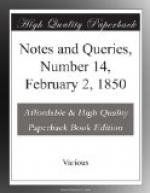C.
Bone-houses.—The number of skulls at Rothewell (No. 11., p. 171.) is greatly exaggerated, nor is the tradition of their being gathered from Naseby battle-field more than a modern invention, the discovery of the bones being within the memory of living persons. Their existence there is most puzzling. The vault, which is very small, is probably coeval with the church, and seems to have been made for the very purpose to which it is applied. When this vast building was erected in the 12th century, may not this vault have been made for the bones disturbed in the old churchyard by so extensive a foundation?
T.
Queen’s Messengers.—In answer to the query of your correspondent “J.U.G.G.,” in No. 12., p. 186., I beg to call his attention to the authority quoted in the passage respecting the “Knightes caligate of Armes,” to which he alludes, in Mr. C. Knight’s London. He will find that he is referred to Legh’s Accedens of Armory, and Upton, De Studio Militari. The latter wrote in the early part of the fifteenth century. We are at present, I believe, without earlier information on such subjects.
Whilst I am writing to you, may I ask you to correct a printer’s error in my query in the same number, where “trepon” appears instead of “jupon”? It may save a query as to what I could mean by the former.
J.R. PLANCHE.
May-day.—In reply to MELANION (No. 12. p. 187.), I would observe that in a collection of Vues des Villes de Londres, &c., published by Pierre Vander at Leyden (without date, but about the time of William III., or early in Anne’s reign), there is a representation of “La Laitiere de May a Londres,” with an enormous head-dress of silver dishes, tankards, and cups, intermixed with flowers. There is no letter-press explanation; but it is evident that the practice of the milk-maids, in carrying their mail-pails balanced on their heads, suggested the idea of carrying this more precious burthen in gala on May-day.
C.
* * * * *
MISCELLANIES.
Gray’s Elegy.—Your correspondent, “A. GRAYAN” (No. 10., p. 150.), in writing on the Elegy in a Country Church-yard, suggests the existence of error or obscurity in the last stanza of the epitaph; and that, if the reading, as it now stand, be faulty, “some amendment” should be suggested.
At the sale of Mason’s collection of Gray’s books and MSS., in December, 1845, I purchased Gray’s copy of Dodsley’s collection (2nd edition, 1758), with corrections, names of authors, &c., in his own hand. The Elegy is the first poem in vol. iv. In the 2nd stanza, the beetle’s “drony flight” is printed and corrected in the margin into “droning.” In the 25th stanza, an obvious misprint of “the upland land” is corrected into “upland lawn;” and, in the 27th stanza, “he would rove” is altered into “would he rove.” These are the only emendations in the Elegy. The care displayed in marking them seems to me indicate that the author had no others to insert, and that the common reading is as he finally left it.




